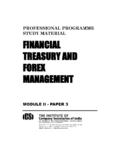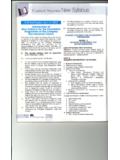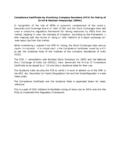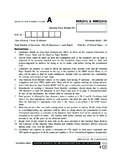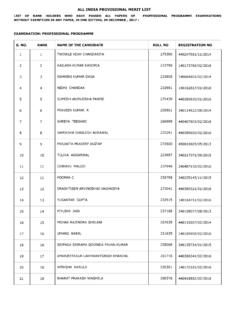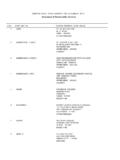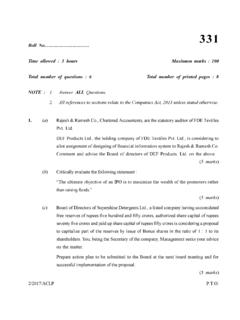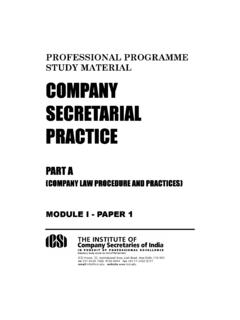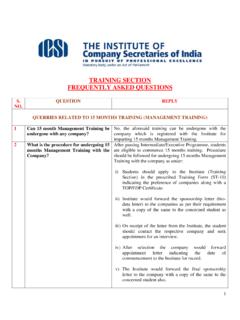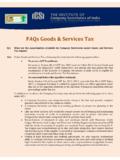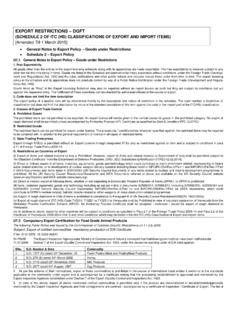Transcription of Lesson 5 Customs Law - ICSI
1 Lesson 5 Customs Law: Part I Introduction and Basic Concepts 6 Lesson 5 Customs Law Introduction and Basic Concepts, Valuation, Assessment of Imported and Export Goods and Procedural Aspects This Lesson is divided into the following parts: I Introduction and Basic Concepts of Customs Law II Valuation, Assessment of Imported and Export Goods and Procedural Aspects LEARNING OBJECTIVES The Custom duty derived its value from the word custom under which whenever a merchant entered a Kingdom with his merchandise, he had to give some gift to the king. Subsequently, this custom formalized into the levy of custom duty or tax on goods imported into and exported from the country was organized through various laws during the British period. After Independence the Sea Customs Act 1878, the Land Customs Act, 1924 and other allied enactments were repealed by a consolidating and amending legislation entitled the Customs Act, 1962.
2 Similarly the Indian Customs Act, 1934 was repealed by the Customs Tariff Act, 1975(CTA). At the end of this Lesson , the students will Have the understanding of the basic and practical aspects of Customs law Be able to value the imported and export goods for payment of duty Understand clearance procedures involved in importation and exportation of goods As per the Customs Act, 1962 the central Board of excise and Customs (the Board) has been given the powers to appoint Customs Ports, Airports and Inland Container Depots (ICD), where the imported goods can be brought in for unloading or loading of export goods. Similarly, powers have been given to the Board to notify places as Land Customs Stations (LCS) for clearance of goods imported or exported by land or by inland water. Lesson OUTLINE Lesson 5 Customs Law: Part I Introduction and Basic Concepts 7 Customs LAW PART I: INTRODUCTION AND BASIC CONCEPTS OF Customs LAW After going through this part you will be able to understand: Meaning and objects of Customs duty Definitions and Concepts Scope and coverage of custom law Types of custom duties Rate of custom duties applicable INTRODUCTION Custom Duty is an indirect tax, imposed under the Customs Act formulated in 1962.
3 The power to enact the law is provided under the Constitution of India under the Article 265, which states that no tax shall be levied or collected except by authority of law . Entry No. 83 of List I to Schedule VII of the Constitution empowers the Union Government to legislate and collect duties on import and exports. The Customs Act, 1962 is the basic statute which governs entry or exit of different categories of vessels, aircrafts, goods, passengers etc., into or outside the country. The Act extends to the whole of the India. Customs Act, 1962 just like any other tax law is primarily for the levy and collection of duties but at the same time it has the other and equally important purposes such as: (i) regulation of imports and exports; (ii) protection of domestic industry; (iii) prevention of smuggling; (iv) conservation and augmentation of foreign exchange and so on. Section 12 of the Custom Act provides that duties of Customs shall be levied at such rates as may be specified under the Customs Tariff Act, 1975 or other applicable Acts on goods imported into or exported from India.
4 STATUTORY PROVISIONS OF Customs ACT, 1962 Customs Act, 1962 came into force from 1-2-1963. It extends to whole of India. The whole Act is divided into XVII chapters comprising of 161 sections. Table showing the contents of Customs Act, 1962 Chapter No. and Title Sections Contents I. Preliminary Section 1 to 2 Short title, extent and commencement and Definitions II. Officers of Customs Section 3 to 6 Appointment and powers of officers of Customs III. Appointment of Customs Ports, Airports, Ware-Section 7 to 10 Appointments of Customs Ports, Airports, Warehousing Stations etc. Lesson 5 Customs Law: Valuation, Assessment of imported and export Goods and procedural aspects housing Stations etc. IV. Prohibitions on importation and exportation of goods Section 11 Powers to prohibit import and export of goods IVA. Detection of illegally imported goods and prevention of the disposal thereof Sections 11A to 11G Provisions for illegal importation of notified goods and prevention of the disposal thereof IVB.
5 Prevention or Detection of Illegal Export of Goods Sections 11H to 11M Provisions for illegal export of specified goods IVC. Power to exempt from the provisions of Chapters IVA and IVB Section 11N Power to exempt V. Levy of, and Exemption from, Customs Duties Sections 12 to 28BA Chargeable section, valuation of goods, Recovery and refund of duty VA. Indicating amount of duty in the price of goods, etc., for purpose of refund Section 28C to 28D Price of goods and incidence of duty passed on to the buyer VB. Advance Rulings Section 28E to 28M Provisions for advance ruling such as authority, application, procedure and powers of authority VI. Provisions relating to conveyances carrying imported or exported goods Sections 29 to 43 Arrival or departure of goods, delivery of export manifest or export report VII. Clearance of imported goods and export goods Sections 44 to 51 Clearance of import and export goods other than by way of baggage and postal articles.
6 VIII. Goods in Transit Sections 52 to 56 Transit and transshipment of goods IX. Warehousing Section 57 to 73 Provision relating to public and private warehouse X. Drawback Sections 74 to 76 Duty drawback on re-export of duty paid goods or material used in the manufacture of goods XA. Special Provisions relating to Special Economic Zone Sections 76A to 76N Omitted in view of the introduction of a special Act, namely, Special Economic Zones Act, 2005 XI. Special provisions regarding baggage, goods imported or exported by post, and stores Section 77 to 90 Special provisions regarding baggage, goods imported or exported by post, and stores XII. Provisions relating to Section 91 to 99 Provisions relating to coastal goods and Lesson 5 Customs Law: Part I Introduction and Basic Concepts 9 coastal goods and vessels carrying coastal goods vessels carrying coastal goods other than baggage and stores XIII.
7 Searches, seizure and arrest Section 100 to 110A Power to search, inspect, examine persons and seizure of goods, documents and things XIV. Confiscation of goods and conveyances and imposition of penalties Section 111 to 127 Adjudication proceedings and confiscation of goods. XIVA. Settlement of cases Sections 127A to 127N Provisions relating to Settlement Commission XV. Appeals and Revision Sections 128 to 131C Procedure and time limits for appeals and revisions XVI. Offences and Prosecutions Section 132 to 140A Offences and cognizance of offences XVII. Miscellaneous Section 141 to 161 Conveyances, duty deferment, licencing of Customs house agent, appearance by authorised representative, delegation of power etc. LIMBS OF Customs LAW Customs Act, 1962 and Customs Tariff Act, 1975 are the two limbs of Customs Law in India which must be read with rules and regulations. The rule making power is delegated to the central Government while the regulation making power delegated to the central Board of excise and Customs (CBEC).
8 There are a number of rules and regulation prescribed from time to time to carry the objective of the Act. Some of the rules and regulations are enumerated here as follows: Baggage Rules , 2016 Customs , central excise Duties and Service Tax Drawback Rules,1995 Re-Export of Imported Goods (Drawback of Customs Duties) Rules, 1995 Customs Valuation (Determination of Price of Imported Goods) Rules, 2007 Customs Valuation (Determination of Value of Export Goods) Rules, 2007 Customs (Advance Rulings) Rules, 2002 Customs (Appeals) Rules, 1982 Customs ( Import of Goods at Concessional Rate of Duty for Manufacture of Excisable Goods) Rules, 1996 Specified Goods (Prevention of Illegal Export) Rules, 1969 Customs (Compounding of Offences) Rules, 2005 Customs (Settlement of Cases) Rules, 2007 Notified Goods (Prevention of Illegal Import) Rules, 1969 Bill of Entry (Electronic Declaration) Regulations, 2011 Customs (Provisional Duty Assessment) Regulations, 2011 Customs House Agents Licensing Regulations, 2004 Lesson 5 Customs Law.
9 Valuation, Assessment of imported and export Goods and procedural aspects Intellectual Property Rights (Imported Goods) Enforcement Rules, 2007 Differences between Rules and Regulations (1) The central Government is authorized to make the rules and the CBEC is authorized to make the regulations consistent with this Act. (2) The powers to make the rules is contained in section 156 whereas the power to make regulations is prescribed under section 157. (3) Rules may provide for all or any of the following matters, namely: (a) the manner of determining the transaction value of the imported goods and export goods under sub-section (1) of section 14; (b) the conditions subject to which accessories of, and spare parts and maintenance and repairing implements for, any article shall be chargeable at the same rate of duty as that article; (c) the detention and confiscation of goods the importation of which is prohibited and the conditions, if any, to be fulfilled before such detention and confiscation and the information, notices and security to be given and the evidence requisite for the purposes of such detention or confiscation and the mode of verification of such evidence.
10 (d) the reimbursement by an informant to any public officer of all expenses and damages incurred in respect of any detention of any goods made on his information and of any proceedings consequent on such detention; (e) the information required in respect of any goods mentioned in a shipping bill or bill of export which are not exported or which are exported and are afterwards re-landed; (f) the publication, subject to such conditions as may be specified therein, of names and other particulars of persons who have been found guilty of contravention of any of the provisions of this Act or the rules. (g) the amount to be paid for compounding and the manner of compounding under sub-section (3) of section 137. Whereas regulations may provide for all or any of the following matters, namely: (a) the form of a bill of entry, shipping bill, bill of export, import manifest, import report, export manifest, export report, bill of transhipment, declaration for transhipment boat note and bill of coastal goods; (b) the manner of export of goods, relinquishment of title to the goods and abandoning them to Customs and destruction or rendering of goods commercially valueless in the presence of the proper officer under clause (d) of sub-section (1) of section 26A; (c) the form and manner of making application for refund of duty under sub-section (2) of section 26A; (d) the form and manner in which an application for refund shall be made under section 27.
